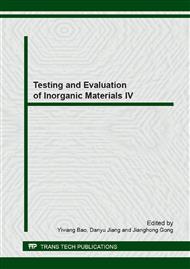[1]
S. Luca, G. F. Maria, L. Beatriz. Properties and performances of innovative coated tools for turning inconel, Machine Tools &Manufacture. 48(2008)815-823.
DOI: 10.1016/j.ijmachtools.2007.12.007
Google Scholar
[2]
J.L. Mo, M.H. Zhu. Tribological characterization of chromium nitride coating deposited by filtered cathodic vacuum arc, Applied Surface Science. 255(2009)7627-7634.
DOI: 10.1016/j.apsusc.2009.04.040
Google Scholar
[3]
X.S. Wan, Y.Y. Shi, J. Ma, et al. Salt spray corrosion behaviour of CrN coatings deposited by arc ion plating, Acta Metallurgica Sinica. 46(2010)600-606.
DOI: 10.3724/sp.j.1037.2009.00759
Google Scholar
[4]
R. Cecchini, A. Fabrizi, M. Cabibbo, et al. Mechanical, microstructural and oxidation properties of reactively sputtered thin Cr-N coatings on steel, Thin Solid Films. 519(2011)6515-6521.
DOI: 10.1016/j.tsf.2011.04.115
Google Scholar
[5]
M.D. Huang, G.Q. Lin, C. Dong, et al. Mechanism of effect of bias on morphologies of films prepared by arc ion plating, ACTA METALLURGICA SINICA. 39(2003)510-515.
Google Scholar
[6]
V.N. Zhitomirsky, I. Grimberg, L. Rapoport, et al. Bias Voltage and incidence angle effects on the structure and properties of Vacuum arc deposited TiN coatings, Surface and Coatings Technology. 133-134(2000)114-120.
DOI: 10.1016/s0257-8972(00)00884-7
Google Scholar
[7]
H. Nakajima, T. Tanaka, M. Hashimoto, et al. Growth structure and magnetic property of CoPt films on GaAs (001) by d. c. - sputter deposition, Thin Solid Films. 459(2004)156-159.
DOI: 10.1016/j.tsf.2003.12.121
Google Scholar
[8]
J.J. Li, W.T. Zheng, Z.S. Jin, et al. Influence of substrate dc bias on chemical bonding, adhesion and roughness of carbon nitride films, Applied Surface Science. 191(2002)273-279.
DOI: 10.1016/s0169-4332(02)00221-0
Google Scholar
[9]
L. Yu, J.W. Liu, J. Zhao, et al. Effect of substrate temperature on the properties of ion plating TiN films, Acta Metallurgica Sinica. 32 (1996) 1270-1274.
Google Scholar
[10]
X. Liu, Z.M. Yu, D.F. Yin, et al. Effect of N2 flow rate and substrate temperature on (Ti, Al) N films deposited by reactive sputtering, Mining and Metallurgical Engineering. 24(2004)80-82.
Google Scholar
[11]
Q. Miao, C. Cui, J.D. Pan, et al. Effect of temperature on the TiN film deposited on AZ91D magnesium alloy by arc-glow depositing technique, Rare Metal Materials and Engineering. 36(2007)2036-(2040).
Google Scholar


